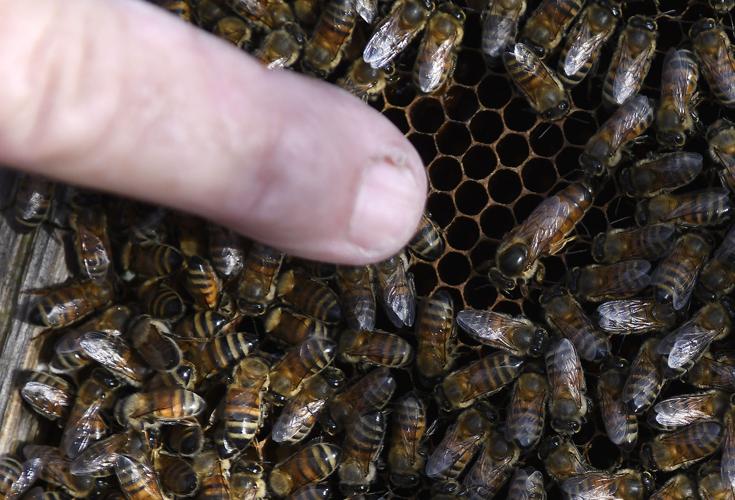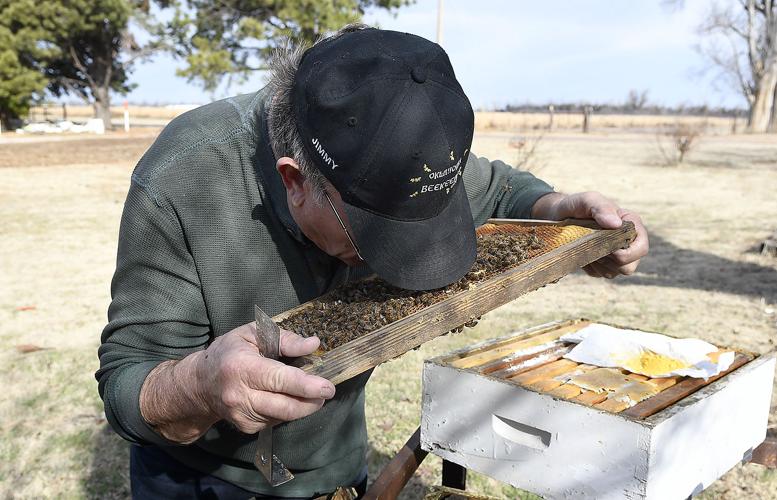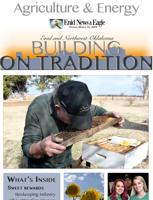
Jimmy Shobert takes a close look at a frame of bees from one of his hives at his home near Laverne in this March 2019 file photo.
LAVERNE, Okla. — Jimmy Shobert, president of Northwest Oklahoma Beekeepers Association, was named Oklahoma’s 2018’s Beekeeper of the Year.
Shobert said he received the award at fall meeting of the state beekeepers association. Albert Lincoln Beekeeper of the Year Award, named in honor of the founder of Northeast Oklahoma Beekeepers Association in 1956 and the first recipient of Beekeeper of the Year award, is awarded to an OSBA member for outstanding services and contributions to furthering the art of beekeeping in the state, OBA reports.
“I’d been up for a number of years ago, but you never know,” Shobert said of the award. “There are lot of bee clubs in Oklahoma. You never know who’s going to win that award.”
Over the past decade, Shobert said there has been a lot more interest in beekeeping, across the state and in Northwest Oklahoma. He said most cities and towns have their own clubs, and some clubs represent a larger geographical area.

Jimmy Shobert, 2018 Oklahoma Beekeeper of the Year, speaks during an interview at his home near Laverne Tuesday, March 19, 2019.
He said Northwest Oklahoma Beekeepers Association has between 60 and 80 members who regularly attend meetings in the spring and fall. He estimated Oklahoma could have anywhere between 1,500 to 2,000 beekeepers.
“Then, there are a lot of people that do bees but don’t belong to any of the clubs,” he said.
Shobert began beekeeping in 1988, when a man from Fargo was widowed and asked Shobert if he wanted his beehives. Shobert said he took the hives with a motive in mind.
“I thought it’d be cool to have my honey,” he said. Shobert said he cared for the hives and began speaking with another beekeeper in Vici. He said he’d visit about two times a year, each visit bringing more questions and leaving with more knowledge.
“I just started getting more bees and more bees,” he said. “I just enjoyed it. Then it got to be fun.”
Shobert said he became the one other beekeepers began to call upon, asking questions and for advice. He also became a local expert, called upon to remove swarms of bees from public places or people’s homes.
“I don’t want to see bees going into somebody’s house because it gets expensive,” he said, explaining sometimes entire walls must be opened up to remove the insects. “I can get the bees out, but I don’t do any carpentry work.”

Left: Jimmy Shobert points out the queen bee in one of his hives at his home near Laverne in this March 2019 file photo. (Photo by Billy Hefton)
Shobert said he likes working with bees because of the work the bees do for us.
“About a third of the food we eat is pollinated by an insect. Most is pollinated by a honey bee,” he said. Shobert noted that production can increase in plants and trees 20 to 50 percent when bees are put on the crop.
“It helps so much,” he said.
Shobert also helps spread the word about beekeeping by doing presentations for groups. He said he usually takes a glass hive with him to show the bees working.
“The young people are the ones that are really interested in it,” he said.
However, he said it was an unexpected group that appreciated his presentation the most.
“The best one I’ve ever done, they called me to a nursing home in Beaver,” Shobert said. “They asked me to come talk to the people. They sat them down all around the table.”
He said he wasn’t expecting anyone to take too much interest but was surprised when he began speaking and sharing the bees in the glass hive.

Jimmy Shobert, 2018 Oklahoma Beekeeper of the Year, speaks at his home near Laverne in this March 2019 file photo. (Photo by Billy Hefton)
“You’ve never seen the smile on somebody’s face as I did that day,” he said. “That was the happiest bunch of people that you’ve ever seen. They were just thrilled to death to see the bees.”
Shobert said he has about 30 hives now and at the peak of his beekeeping had about 75 hives.
“You’re going to lose maybe 10 percent of your hives every year,” he said. “You’re going to lose a few no matter how good you are.”
Shobert said when he began, he kept his hives behind his house and never fed the bees or treated them. He said he would not recommend that route for new keepers.
“If you’re not treating your bees with something in the first year, or year and a half, you are going to lose your bees,” he said.
He said for years there was a lot of talk about colony collapse disorder, in which hives would be devastated. Shobert said there were three factors in Oklahoma that could have contributed to keepers losing hives.
“We’ve been in a drought for seven or eight years out here, not getting good pollen from the trees,” he said. “They’re not getting the good stuff like they used to.”
He said pesticides, not just from farmers but those who are tending to their lawns, could also be a factor.
“Twenty years ago, 35 years ago, you didn’t see all the spraying,” Shobert said.

Jimmy Shobert points out the queen bee in one of his hives at his home near Laverne Tuesday, March 19, 2019.
The third factor that could be impacting hives are disease and infestations by other insects and mites. He said varroa mites are parasites that attached themselves to bees.
“A lot of people say, ‘Well, I’m not going to treat my bees. I am just going to let them survive on their own,’” he said. “If you see a mite in your hive you’re infested. If you see two mites on the back of your bees you’re really infested.”
He said the small, black hive beetles can clear out and devastate an entire hive.
“He’ll run the bees out of the hive if you don’t take care of him,” Shobert said. “If you see him, you’ve got to do something.”
He said American foulbrood, caused by a spore-forming bacteria, is a highly infectious bee disease. It is the most widespread and destructive of the bee brood diseases. It must be treated, if detected.
Shobert said the amount of honey he gets each year depends on factors such as the weather, rainfall and how many hives he has.
“I run 30 or 40 hives in the summertime. Usually, I’ll get 400, 500 gallons of honey,” he said. “The year 2000 was the best year I ever had. I had some hives that made 380 pounds of honey, which is unheard of in Oklahoma.”
Building on Tradition is a special section that will publish in the Enid News & Eagle for eight Sundays in February, March and April 2019.…
He said the average Oklahoma hive produces about 68 pounds of honey in a year. But, depending on the bees’ source of food, water and good weather, they could produce much more. “If you get a good clover field, they can fill that little box every three days,” he said.
Because of the weather and lack of rain, Shobert said last year was his worst year ever for beekeeping, outside of winning his award.
“You’ll learn more on a bad year than you will on a good year,” he said. “On a bad year, like last year, you’ll figure out what’s going on with your bees on a bad year. You learn how to take care of your bees.”
His advice for new beekeepers is to start small but not too small.
“It’s not cheap to get into bees,” he said. “You want to start out with at least two to three hives of bees.”
Having that number of hives allows for comparisons between them, to determine what works best. Also, if a hive is lost to disease or other circumstance, Shobert said you can always split one of the other hives.

Jimmy Shobert pulls a frame of bees from one of his hives at his home near Laverne Tuesday, March 19, 2019.








